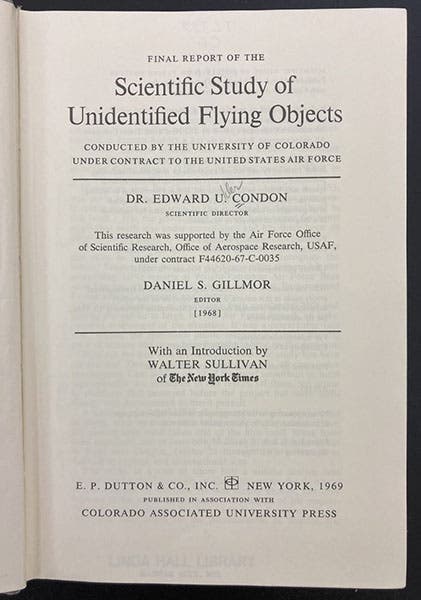Scientist of the Day - Edward Condon
Edward Uhler Condon, an American physicist, was born Mar. 2, 1902. Condon by most accounts was not a brilliant scientist; he did some important work on radar during the Second World War, and he chaired the National Bureau of Standards after the War, but he never made the kind of discovery for which Nobel prizes are awarded. But Condon is worth remembering, for two reasons. One, he was one of the early targets of the House Un-American Activities Committee (HUAC), beginning in 1948. He was repeatedly accused of having Communist sympathies and of being a grave security risk, and this went on for seven years. The striking feature of this witch hunt in Condon’s case is that there was never a hint of anything un-American or Communist-sympathizing about Condon – he was as patriotic as they come. Condon’s tribulations remind us how awful those post-war years were, when men and women could be besmirched and pilloried without the slightest bit of evidence. Condon survived his slanders for a long time, because he was blameless, but the HUAC never gave up, and in 1955, when he was working for Corning Glass, he finally lost his security clearance and had to resign his position to prevent Corning from losing their government contracts. Richard Nixon, smarmy and disgraceful even then, took credit for getting Condon's clearance revoked. What a trial those years must have been for all those impugned scientists who were simply trying to do jobs that they felt were important!
Before he ran afoul of HUAC, in 1945, Condon had performed a valuable service to the country by insisting that nuclear energy should be placed under civilian rather than military control. With Condon's help, Senator Brien McMahon drafted the Atomic Energy Act of 1946, which established the civilian Atomic Energy Commission. The photograph from 1945 shows Condon at far left, with McMahon next to him, when they were working out the details of the proposed legislation, and no doubt wondering when the speaker, astronomer Harlow Shapley, was going to shut up. The woman in the photograph is the remarkable Helen Gahagan Douglas, U.S. representative from California. She later ran against Nixon for the U.S. Senate seat in 1950 and lost, but not really, for in defeat she gave us the memorable Nixon epithet, "Tricky Dick."
The other reason for remembering Condon is his authorship of the Condon Report. He had been teaching at the University of Colorado since 1963, and in 1966 it was decided to take a long look at the 19 years of reports of UFO activity that had accumulated. The U.S. Air Force had been doing this with its Project Blue Book, but it didn't seem to be getting anywhere, so an ad-hoc advisory committee suggested turning the matter over to civilian academics, and Condon was chosen to head the committee. For two years they read all the reports and results of investigations, and late in 1968 Condon delivered his report to the Air Force with the official title of Final Report of the Scientific Study of Unidentified Flying Objects, but which is nearly always referred to as the Condon Report. It was published in January 1969, and re-issued immediately as a mass-market and best-selling paperback, and you can read all 965 pages online if you wish. But you get the drift by the end of the second short paragraph: "As indicated by its title, the emphasis of this study has been on attempting to learn from UFO reports anything that could be considered as adding to scientific knowledge. Our general conclusion is that nothing has come from the study of UFOs in the past 21 years that has added to scientific knowledge. Careful consideration of the record as it is available to us leads us to conclude that further extensive study of UFOs probably cannot be justified in the expectation that science will be advanced thereby."
The Condon Report has become infamous among UFO buffs for giving short shrift to claims of extra-terrestrial activity on earth, but it did perform a valuable service in discouraging younger scientists, looking to make their mark, from wasting their time in a field that so far had borne absolutely no fruit. Nor has that situation changed in the ensuing 54 years since the appearance of the Condon Report.
One of the more valuable practices begun by the American Institute of Physics in the 1960s was to conduct oral interviews with physicists who were getting on in years, preserving their personal memories before they passed away, and Condon was the subject of three interview sessions between 1967 and 1973. They are available online as transcripts, and I don't expect anyone to read these, because they are long and somewhat opaque to those without a physics background, but it astounds me how much people like Condon could remember about meetings and encounters from the 1930s and 40s, including all sorts of technical details. The reminiscences about his years of struggle with the Red-scare Congressmen are quite sobering to read. It includes a great story about Harry S Truman blasting the HUAC at a national meeting of the AAAS in 1948, of which Condon was President at the time, essentially saying that the most un-American activities under way at the time were those of the House Committee.
Finally, to end on a light note, here is a short 1-minute YouTube video that celebrates in a lively fashion four people who were all born on Mar. 2. The last is Condon, for whom they unfortunately used a glum photo, but you might enjoy seeing what a granfalloon you get when your criterion of selection is a common birthday.
Dr. William B. Ashworth, Jr., Consultant for the History of Science, Linda Hall Library and Associate Professor emeritus, Department of History, University of Missouri-Kansas City. Comments or corrections are welcome; please direct to ashworthw@umkc.edu.








